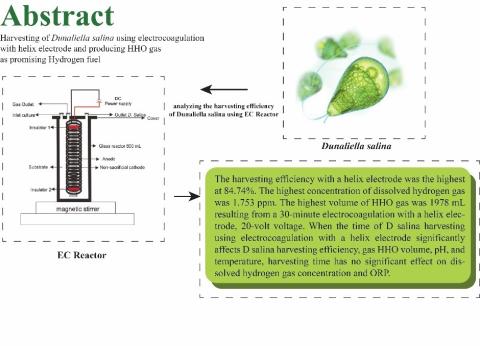You are here
Harvesting of Dunaliella salina using electrocoagulation with helix electrode and producing HHO gas as promising Hydrogen fuel

Biofuels obtained from renewable sources are the only alternative in the global economy from a sustainable point of view. Microalgae have shown tremendous potential as a major source of biomass production that can be used as biofuels. At the same time, gas hydrogen is a non-polluting energy source because it is produced from renewable sources. This study aims to analyze the harvesting efficiency of Dunaliella salina using electrocoagulation with a helix electrode and having HHO gas as hydrogen fuel. D salina harvesting using an EC reactor made of acrylic is done on a batch scale. Helix-shaped type 304 stainless steel is the cathode, and solid cylindrically-shaped Fe is the anode. The voltage set is 20 Volts, while the electrolysis time is varied between 1. 5. 10. 15. 20. 25 and 30 minutes. The harvesting efficiency of D salina using electrocoagulation with a helix electrode was the highest at 84.74%. The highest concentration of dissolved hydrogen gas was 1.753 ppm. The highest volume of HHO gas was 1978 mL resulting from a 30-minute electrocoagulation with a helix electrode, 20-volt voltage. Nanoscale glovaries are formed on the electrode through heterogeneous nucleation at the solid-liquid interface. After nucleation, the nanobubbles grow, and the buoyancy forces of the growing bubbles cause gas release from the cathode surface. This process continues until it causes many bubbles to produce 1978 mL HHO gas for 30 minutes. During the study, the convex HHO gas formed helped remove coagulated D salina floc through electro-flotation. When the time of D salina harvesting using electrocoagulation with a helix electrode significantly affects D salina harvesting efficiency, gas HHO volume, pH, and temperature, harvesting time has no significant effect on dissolved hydrogen gas concentration and ORP.
